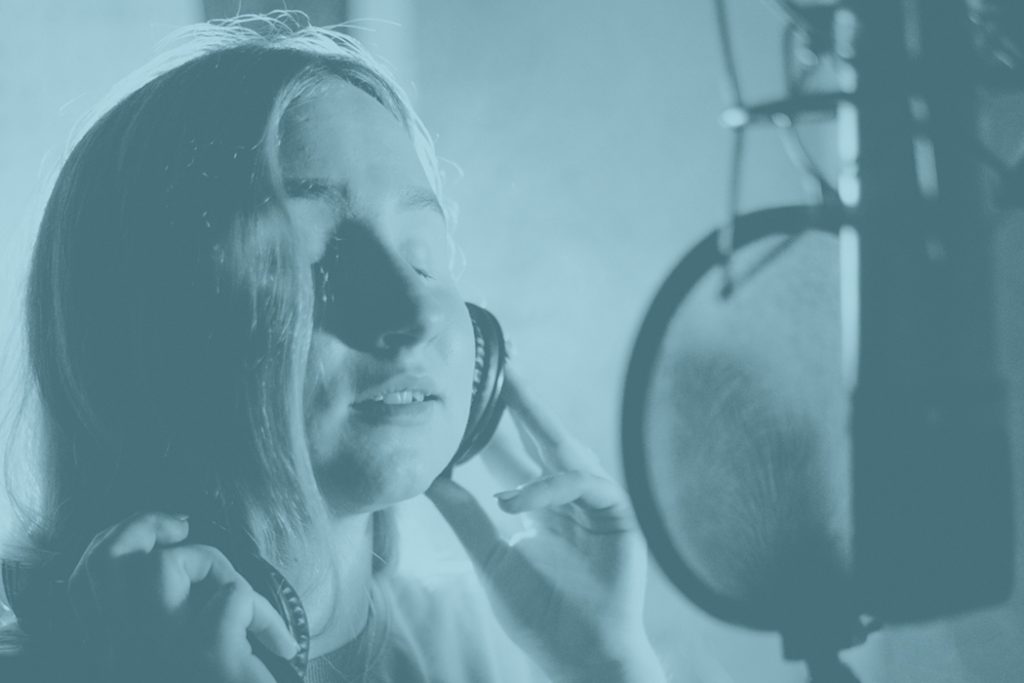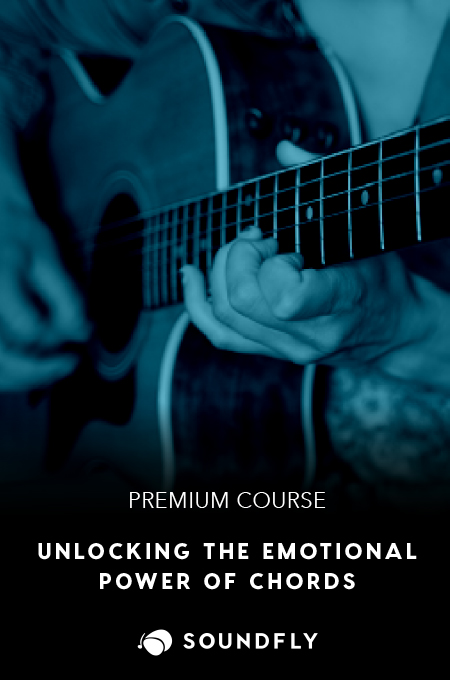+ Learn from Grammy-winning pop artist Kimbra how to harness the full creative potential of your voice in song. Check out her course.
So at this point you’ve probably nailed recording your vocals at home. The COVID-19 pandemic has left us no choice, has it?
But are you finding the process a little stale these days? You track your lead vocals, your harmonies, and your improvised ad libs — your song sounds great, but lacks a little something special? You’re not alone, and now is the perfect time to experiment with a creative vocal effects chain on your own, from the comfort of your own home.
All you need is your voice, a microphone, a DAW (digital audio workstation), and your imagination. So what do you say? Are you ready to take your song to the next level?
If you’re looking to improve your home vocal recording capabilities and skills, you can check out Soundfly’s comprehensive course, Modern Pop Vocal Production. For now, let’s take a look at some simple vocal effects you can create on your own right away.
1. Reverse It
Struggling to come up with an interesting ad lib? Try recording something and reversing the track. All the notes will remain the same, but it will sound fresh and unlike anything you could’ve come up with otherwise, both melodically and texturally. And if you don’t quite like the melody in reverse but like the way the effect sounds, you can re-record the snippet as it sounds in reverse, then reverse that!
2. Chop It
Chopping is becoming more and more prevalent in music these days, and for good reason. It’s a creative way to make an organic vocal take stand out. This works great in hooks, post-choruses, bridges, or as ad libs.
To chop your vocals, simply record a phrase as usual. Then splice the vocal take into sections of different lengths (a common place to splice is where the notes change). And then you can re-assemble the sections to create a new melody, regardless of how the words fit together or whether or not they make any sense.
Feel free to leave some sections out, repeat some more than once, or completely change the order. The amazing thing about chopping is that you’ll never know what you can create or how it will sound until you try it, so the key is to have fun with it!
3. Use Your Vocals as an Instrument
Similarly to chopping, you can take a section of your vocal take and use it as a sample. For example, take a small section where you sing a particular word and use it as its own instrument. You can use a sampler plug-in that will allow you to use your MIDI controller to play the melody using your sample. Alternatively, you can change up the duration and pitch of each bit of your sample to create your melody.
In fact, you can turn any sample or sound source into a synth to play like an instrument. Check out Advanced Synths and Patch Design for Producers to learn about all the various types of synthesis, sound design, and sampling techniques.
4. Use a Vocoder
A more sophisticated way to use your voice as an instrument is to use a vocoder plug-in. A vocoder uses two inputs: a carrier, such as a synth MIDI track, and a modulator — in this case, your vocals. Your vocals get deconstructed and analyzed by the vocoder. Their characteristics then get applied to the carrier sound. So essentially, your synth then sounds a bit like your voice.
When using a vocoder, you don’t have to worry about singing in tune because the notes will be controlled by your synth MIDI, but you do have to exaggerate your enunciation so that all the words come across as clearly as possible.
5. Auto-Tune It
Auto-tune that makes the singer sound better than they actually do in real life is often frowned upon, but when used intentionally and in a creative way, it can actually create an interesting effect. As with all these effects, don’t overuse it — but certain ad libs, harmonies, and at times even lead vocals can benefit from a little creative auto-tuning.
One great idea is to create a melody with your auto-tune that’s impossible to sing, such as one with really quick transitions between notes that are far apart on the scale. This makes it obvious that the choice was intentional and adds something that otherwise would have been impossible to achieve.
+ Enjoy access to Soundfly’s suite of artist-led music learning content for only $12/month or $96/year with our new lower price membership. Join today!

6. Shift the Pitch
On a similar note, you can take entire phrases and shift them up or down by entire octaves. This is most often done to complement a regular vocal track and add a bit of texture, but you can use it in any way you like. Try using it on harmonies and background vocals, or even on some of your chopped sections.
7. Shift the Formant
Formants result from the acoustic resonance in the vocal tract and are responsible for the frequency and timbre or your singing voice.
If you’ve already tried shifting the pitch, you likely would’ve noticed a shift in the formant, as well. Shifting your voice up by an octave probably makes you sound a bit like a chipmunk. To avoid this, shift the pitch up and shift the formant down. This will more or less maintain the acoustic quality of your voice.
You can also play around with the formant on its own, without changing the pitch. For example, if you’d like your voice to sound more female or male, you can shift the formant up or down. This trick is often used when stacking vocals from a single person to create a choir-like effect.
+ Explore more on Soundfly: “Student Spotlight: Kiri Sparks on Overcoming Self-Doubt with Aplomb.”
8. Turn Up the Decay
In simple terms, decay is the time it takes for the note to die down to silence. You can use this to turn your vocals into a pad and help fill out the space in your production. To do this, record a simple “Hmm” or “Ahh” sound. Add reverb to it and turn up the decay for as long as you want the “pad” to be on. You can even layer these vocals to create chords and use them in the background of your song.
You don’t have to stop at sung vocals, either. I’ve heard songs with the singer’s breaths intentionally prolonged with decay, creating a unique sound effect.
9. Use a Tremolo
A tremolo is a simple modulation in volume (not to be confused with vibrato, which is a slight modulation in pitch and often happens naturally when we sing). When applied to a vocal track with a held note, tremolo can create a pulsing or even stuttering effect, giving the vocal a more percussive role.
To achieve the tremolo effect, you can use a plug-in and set parameters like how frequently you want the modulation to occur and how much variation you want to see in volume. If you don’t have access to a plug-in, you can achieve a similar effect by splicing your vocal track and adjusting the volume of each section manually.
10. Use a Sidechain
If you like the idea of a tremolo effect, but want more control over the tempo and rhythm of the modulation, you can play around with sidechaining your vocal.
Sidechaining is used to apply an effect to one instrument in relation to the volume and tempo of another instrument. It’s typically used to make sure every instrument cuts through your mix. For example, you can add a sidechain compressor to the bass relative to the kick drum. This way, the compressor will increase the volume of the bass whenever the kick drum is present, preventing it from being drowned out by the drum.
You can use the same logic to create interesting variations in your vocal track. Why not modulate the volume of the vocal by sidechaining it to a drum track? You can then mute the drum track entirely — the pattern will still be heard through the vocal, creating a mysterious ghost beat.
+ Read more on Flypaper: “9 Bedroom Pop Artists We Can’t Stop Listening to Right Now.”
11. Reverse the Reverb
You’ve likely heard this one in Pop and EDM music, but reversing your reverb throw is a neat trick that can elevate a song in just about any genre by creating suspense and a sense of anticipation before the lead vocal comes in (or before the drop). Here’s how to do it:
- Copy the first few seconds of your lead vocal to a new track, reverse it and add a generous amount of reverb on it.
- Bounce the output of that track to a new track (this will permanently keep the reverb on the recording), making sure to leave 3-4 second of reverb at the end.
- Reverse this once again — you should now have a vocal that starts with a gradually growing reverb.
- Line it up with your original vocal track and cut it off where the lead vocal starts.
Play it all together and you should have your reversed reverb effect, followed by your original lead vocal.
12. Pan It
Ad libs, harmonies, and other vocal effects are usually never panned in the center with the lead vocal, as that creates a cluttered mix. You can’t overwhelm the listener, so spread it out and pan secondary vocals slightly to the right or left. This will create an overall sound that has lots of depth and space. You can even automate a back-and-forth effect, and have your vocals swimming from left to right and back again, to give the sound some of movement.
Don’t be afraid to experiment with this effect for lead vocals, too. Just don’t overdo it — the majority of your lead vocal should still be panned in the center — but an unexpected twist here and there could make your song stand out in a big way.
Which one of these effects will you be trying in your next song? Let us know in the comments!
Don’t stop here!
Continue learning with hundreds of lessons on songwriting, mixing, recording and production, composing, beat making, and more on Soundfly, with artist-led courses by Ryan Lott, Com Truise, Jlin, Kiefer, RJD2, and Kimbra: Vocal Creativity, Arranging, & Production.




